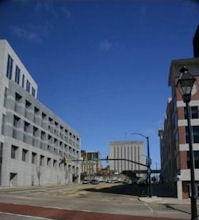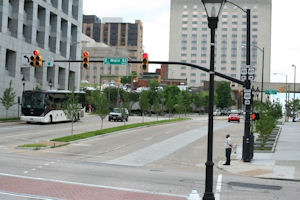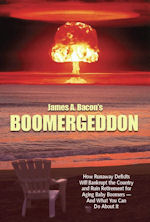About Bacon’s Rebellion
Bacon's Rebellion is Virginia's leading independent portal for news, opinions and analysis about state, regional and local public policy. Read more about us here.
Beyond Beautification
The Capital Trees project in downtown Richmond shows how public and private investment in urban canopy can advance strategic community goals like reducing storm water runoff and cleaning up the James River.
In November 2009, the Garden Club of Virginia invited Rachel Flynn, then the City of Richmond’s planning director, to speak at its Conservation Forum in Charlottesville. She described how trees played a critical role in defining city streetscapes. Although the City of Richmond had funded an extensive planting program, she said, many trees had died. By her count, some 500 empty tree wells were scattered around town.
Intrigued by the presentation, Jeanette McKittrick, president of the Three Chopt Garden Club contacted Flynn and arranged for her to give the four Richmond-area garden club presidents a tour of the city. In that tour, she gave a running commentary about gateways, landscapes, parks and streestscapes and their importance to the city's identity. That tour inspired a dialogue among the members of the Boxwood, James River, Three Chopt and Tuckahoe of Westhampton garden clubs. Trees, they realized, play a dual role. They are key components in beautification projects, and they are essential to the environment as well.
Over the years, the Garden Club of Virginia has been most closely identified with historic gardens, from Monticello to Maymont, from the Governor’s Mansion in Richmond to the grounds at the University of Virginia. Perhaps it was time to try something new – beautification with an environmental twist.
 The four Richmond-area chapters approached the city to join them in a major demonstration project – the landscaping of 14th Street between Bank and Main Streets in the heart of downtown. The goals: to soften a barren, concrete street scene and to reduce storm water overflow into Richmond’s antiquated sewer system.
The four Richmond-area chapters approached the city to join them in a major demonstration project – the landscaping of 14th Street between Bank and Main Streets in the heart of downtown. The goals: to soften a barren, concrete street scene and to reduce storm water overflow into Richmond’s antiquated sewer system.
“It was a concrete canyon. It was ugly,” recalls Susan Robertson, who at the time served as president of the James River Garden Club. Not only was the street an uninviting place to walk, it contributed to the city’s most pressing environmental problem. “There was a significant elevation drop,” she explains. “In heavy rains, water came down, drained into the sewer and ran straight into the river.”
While separate sewer and storm-water systems serve two-thirds of the city, the downtown area still has a combined sewer overflow system, parts of which date to the 19th century. Ages ago, it was state of the art. Today it’s a liability. In heavy rains, storm water merges with sewage to overwhelm the city’s sewage treatment plant, and raw effluent washes into the James River. Upgrading the system would cost roughly $500 million, and the city is under the gun from the State Water Control Board to make steady and demonstrable progress in reducing the overflow.
Planting more trees downtown won’t solve the problem by itself, but the Capital Trees project could make a contribution. “We’re looking at these pilot projects to see how green infrastructure can support the gray infrastructure,” says Michelle Virts, deputy director at the city’s Department of Public Utilities. “The potential exists to reduce the investment needed.”
“One mature shade tree deflects 13,000 gallons of water a year from entering neighboring streams,” says Robertson. As a bonus, trees prevent silt from entering streams, filter carbon monoxide and other pollutants, trap airborne particulates, muffle urban noise, provide cooling shade in summer, act as windbreaks in winter, and function as carbon sinks.
After their tour with Flynn, the Garden Club ladies set about educating themselves about urban tree canopies. They drew heavily from the pioneering work of Casey Trees in Washington, D.C., which has the mission of restoring and protecting trees in the nation’s capital. Casey Trees had developed best practices for selecting trees appropriate for specific settings, for making sure they had sufficient soil and root space to thrive and for making sure someone watered them as they matured.
As design partners, McKittrick recruited Jay Hugo, an architect and principal with Richmond-based 3North, and Keith Whipple, with Charlottesville-based WaterStreet Studio, both of whom donated most of their work to the effort. Capital Trees also raised private funds, including foundation money, to help pay for the project. All told, the garden club ladies managed to raise about 60% of the roughly $200,000 project cost, while the city contributed the rest.
Contractors removed truckloads of concrete and planted a triple allee (three rows) of trees in planting beds comprised of rain gardens and underground bio-filtration systems. With the guidance of arborist Joel Koci, Capital Trees selected sterile ginkgos and swamp white oaks for their heat tolerance and overall hardiness, and for their low ground-level diameter that will reduce pavement heaving. The experts estimated that the filtration system would reduce up to 50% of the phosphorus in the run-off, along with anti-freeze, oils and other urban pollutants that otherwise would wind up in the James.
Those pre-project estimates have to be confirmed by testing, of course. Virts says the city is monitoring the newly green 14th Street for sediments and nutrients and will compare results to a similar block downtown to calculate the improvement. If the costs and benefits are positive, trees and rain gardens could become important components of the city’s toolbox to attain groundwater pollution-reduction goals.
Enthusiasm for trees in Richmond appears to have reached a critical mass. Mayor Dwight Jones has delivered on a campaign promise to plant 2,000 trees per year. The city has two arborists on staff and has established an Urban Forestry Commission to serve as an advisory board to the Department of Public Works. The four garden clubs, whose combined membership amounts to 400 or so, represent a large cadre of volunteers willing to raise money, act as advocates and even get their hands dirty planting.
The garden clubs are bursting with enthusiasm and ideas. Among other projects, they have done an “extreme stream” makeover in partnership with the James River Association: cleaning up trash and planting trees to create a riparian buffer and hold the soil. In cooperation with the City of Richmond, they are experimenting with the use of "tree shelters" -- perforated plastic pipes around the trunks of young trees to protect them from insects, lawn mowers and marauding deer. And they have emerged as advocates of better management practices to increase the city’s return on investment in trees.
One thing Capital Trees would like to see, says Robertson, is for the city to set up a tree inventory that tracks the locations, species, age and other data on trees on public property. The average life of a new tree planted by the city is only seven years. "That's way too short," she says. "The city can get far more benefit from its investment in trees with some changes in selection, planting practices and maintenance."
Christopher Beschler, deputy chief administrative officer for the city, says the initial impetus for the mayor’s commitment to plant 2,000 trees a year was to promote community development: Replacing dead trees would rebuild the urban canopy and beautify neighborhoods. Thanks to Capital Trees, the thinking about trees has broadened. Beschler endorses the idea of creating an asset management system for city trees – “we definitely need to do that, that is on our plate” – and he’s intrigued by the potential for trees to mute the need for capital spending on the storm water system.
Hugo, whose love of trees runs in the family – his mother has authored the books “Remarkable Trees of Virginia” and “Seeing Trees” – would go a step further. The City of Richmond should think strategically about its tree plantings, he says. Instead of replacing a tree here and tree there, he envisions making a big visual and environmental impact by creating green corridors. He is particularly enamored with the idea of transforming 10th Street into a green thread running from the state Capitol down to the canal. If properly branded and promoted -- he humbly advances the name "Jefferson Greenway" -- such an initiative could align the interests of state, the city and private property owners in paying for the project.
Over and above the benefits of shade, beautification and storm-water management, Hugo says, the city needs to consider the role of “place making,” the art of using design, including streetscapes, to make locations more appealing. The broad, tree-lined Monument Avenue is a classic example of how trees contribute to creating one of the city’s most beloved boulevards, a place where people jog, throw Frisbees, walk their dogs and even gather on summer evenings in lawn chairs to socialize. Great places can enhance property values, broaden the tax base and repay the city its investment.
It’s time to think of trees as more than an adornment, more than a “feel good” answer to beautifiers and tree huggers. Trees are a tangible asset; they make a real contribution to cleaning the water, purifying the air and enhancing property values. Richmonders need to think seriously about how to manage that asset more efficiently and how to leverage the city’s investment to enhance quality of life and economic potential.
This article was written under a sponsorship of Bon Secours Virginia Health System.


